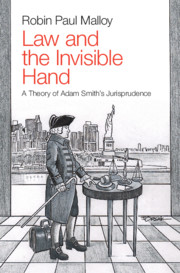Book contents
- Law and the Invisible Hand
- Law and the Invisible Hand
- Copyright page
- Dedication
- Contents
- About the Cover
- Figures
- About the Author
- Preface
- Acknowledgments
- Guide to Citations by Adam Smith
- 1 Introduction
- 2 Setting the Stage
- 3 Social Organization in the Informal Realm
- 4 Social Organization in the Formal Realm
- 5 Integrating the Informal and Formal in Smith’s Theory
- 6 The Spectator View
- 7 Judgment and Justice
- 8 The Sentiment of Common Interest
- 9 The Impartial Spectator, Homo economicus, and Homo identicus
- 10 Understanding the Four Stages of Progress
- 11 Adam Smith in American Law
- 12 Parting Thoughts
- Bibliography
- Index
7 - Judgment and Justice
Published online by Cambridge University Press: 27 September 2021
- Law and the Invisible Hand
- Law and the Invisible Hand
- Copyright page
- Dedication
- Contents
- About the Cover
- Figures
- About the Author
- Preface
- Acknowledgments
- Guide to Citations by Adam Smith
- 1 Introduction
- 2 Setting the Stage
- 3 Social Organization in the Informal Realm
- 4 Social Organization in the Formal Realm
- 5 Integrating the Informal and Formal in Smith’s Theory
- 6 The Spectator View
- 7 Judgment and Justice
- 8 The Sentiment of Common Interest
- 9 The Impartial Spectator, Homo economicus, and Homo identicus
- 10 Understanding the Four Stages of Progress
- 11 Adam Smith in American Law
- 12 Parting Thoughts
- Bibliography
- Index
Summary
Interpretation is only the first step in understanding the role of the impartial spectator in Smith’s jurisprudence. The second function of the spectator device is that of judgment. Once people can communicate, they are better able to cooperate and to truck, barter, and exchange. They are equipped to enter into contracts and to describe and exchange assets. In doing so, however, they also need to make judgments. They need to make judgments concerning the meaning of words, the terms of a contract, and about right and wrong behaviors. The spectator is the mechanism Smith uses to discuss judgment, to assess the praiseworthiness and blameworthiness of conduct, and to evaluate conformity with the core shared values he has identified for humankind.1
- Type
- Chapter
- Information
- Law and the Invisible HandA Theory of Adam Smith's Jurisprudence, pp. 77 - 81Publisher: Cambridge University PressPrint publication year: 2021

